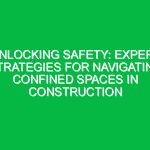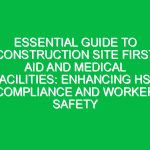Construction work zones are bustling areas where safety is paramount. With heavy machinery, construction workers, and passing vehicles all sharing the same space, the potential for accidents is high. Therefore, implementing effective traffic control strategies is not just a recommendation; it’s a necessity. In this article, we delve into the essential traffic control strategies that can significantly enhance safety in construction work zones. By adhering to these guidelines, we can ensure a safer environment for workers and the general public alike.
Understanding the Importance of Traffic Control in Construction Zones
Traffic control in construction zones is critical for several reasons. It helps manage the flow of vehicles and pedestrians, minimizes confusion, and reduces the risk of accidents. Effective traffic control strategies also ensure that construction activities can proceed smoothly without unnecessary interruptions. In the realm of Health Safety and Environment (HSE), traffic control is a cornerstone of maintaining safety and preventing incidents that could lead to injuries or fatalities.
Key Components of Effective Traffic Control Plans
An effective traffic control plan (TCP) is the backbone of safety in construction work zones. A well-designed TCP addresses the following key components:
- Assessment of the Work Zone: A thorough assessment of the work zone is crucial to identify potential hazards and determine the appropriate traffic control measures.
- Signage and Markings: Proper signage and markings are essential for guiding vehicles and pedestrians safely through the work zone.
- Barriers and Buffer Zones: Barriers and buffer zones protect workers from incoming traffic and provide a safe working space.
- Flaggers and Traffic Controllers: Trained flaggers and traffic controllers play a vital role in directing traffic and ensuring compliance with the TCP.
Strategies for Maximizing Safety in Construction Work Zones
To maximize safety in construction work zones, several strategies can be employed. These strategies are designed to protect workers, pedestrians, and drivers, ensuring that construction activities do not pose undue risks.
Implementing Advanced Warning Systems
Advanced warning systems are crucial for alerting drivers to upcoming construction zones. These systems can include warning signs, flashing lights, and electronic message boards that provide real-time information about the work zone ahead. By giving drivers ample warning, these systems allow for safe navigation through or around the construction area.
Utilizing Protective Barriers
Protective barriers serve as a physical shield between traffic and the work zone. These barriers can be made of various materials, such as concrete, water-filled barriers, or impact-absorbing devices. They not only protect workers but also prevent vehicles from accidentally entering the work zone.
Ensuring Proper Signage and Markings
Clear signage and markings are essential for guiding traffic safely through construction zones. Signs should be visible, legible, and placed at strategic locations to provide drivers with clear instructions. Pavement markings can also help delineate lanes and direct traffic flow, reducing confusion and the risk of accidents.
Deploying Trained Flaggers and Traffic Controllers
Flaggers and traffic controllers are the human element of traffic control, providing direct guidance to drivers and pedestrians. These individuals must be properly trained and equipped with the necessary tools, such as flags, signs, and communication devices, to perform their duties effectively. Their presence is especially important in complex or high-traffic areas where automated systems may not suffice.
Creating Safe Pedestrian Pathways
Construction work zones can be particularly hazardous for pedestrians. To ensure their safety, it’s important to create designated pedestrian pathways that are clearly marked and separated from vehicular traffic. These pathways should be free of obstacles and provide a safe route around or through the work zone.
Maintaining Open Communication and Coordination
Effective communication and coordination among all parties involved in the construction project are essential for maintaining safety. This includes regular meetings to discuss the TCP, updates on construction activities, and any changes that may affect traffic control measures. Open communication ensures that everyone is aware of their responsibilities and can work together to prevent accidents.
Conclusion: The Path to Safer Construction Work Zones
Maximizing safety in construction work zones is a multifaceted challenge that requires careful planning, coordination, and execution. By implementing the essential traffic control strategies discussed in this article, we can create a safer environment for workers, pedestrians, and drivers alike. From advanced warning systems and protective barriers to proper signage and trained personnel, each element plays a crucial role in preventing accidents and ensuring the smooth progress of construction activities. Let’s commit to these strategies and work together towards safer construction work zones.
In summary, the key points to remember for maximizing safety in construction work zones include:
- Understanding the critical role of traffic control in construction zones.
- Developing and implementing an effective traffic control plan.
- Employing advanced warning systems, protective barriers, and proper signage.
- Deploying trained flaggers and traffic controllers.
- Creating safe pedestrian pathways.
- Maintaining open communication and coordination among all parties involved.
By focusing on these strategies, we can significantly reduce the risk of accidents and create a safer environment for everyone involved in or affected by construction work zones.


